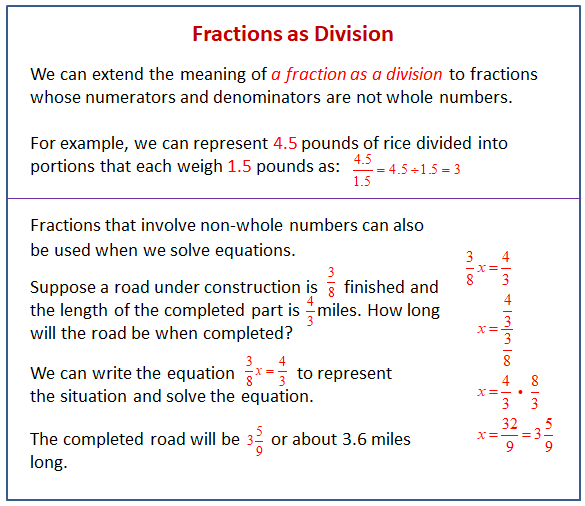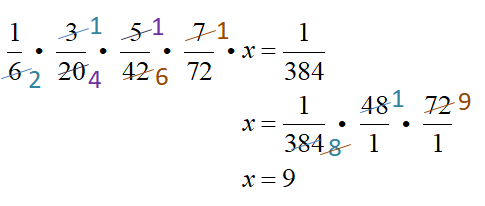Illustrative Mathematics Unit 6.6, Lesson 5: A New Way to Interpret a over b
Learning Targets:
- I understand the meaning of a fraction made up of fractions or decimals, like 21/0.07 or 4/5 / 1/2.
- When I see an equation, I can make up a story that the equation might represent, explain what the variable represents in the story, and solve the equation.
Related Pages
Illustrative Math
Grade 6
Lesson 5: A New Way to Interpret a over b
Let’s investigate what a fraction means when the numerator and denominator are not whole numbers.
Illustrative Math Unit 6.6, Lesson 5 (printable worksheets)
Lesson 5 Summary
The following diagram shows the meaning of a fraction made up of fractions or decimals.

Lesson 5.1 Recalling Ways of Solving
Solve each equation. Be prepared to explain your reasoning.
- 0.07 = 10m
- 10.1 = t + 7.2
Scroll down the page for the solutions to the “Are you ready for more?” section.
Lesson 5.2 Interpreting a/b
Solve each equation.
- 35 = 7x
- 35 = 11x
- 7x = 7.7
- 0.3x = 2.1
- 2/5 = 1/2x
Are you ready for more?
Solve the equation. Try to find some shortcuts.

Lesson 5.3 Storytime Again
Take turns with your partner telling a story that might be represented by each equation. Then, for each equation, choose one story, state what quantity x describes, and solve the equation. If you get stuck, draw a diagram.
- 0.7 + x = 12
- 1/4 x = 3/2
Lesson 5 Practice Problems
- Select all the expressions that equal 3.15/0.45
A. (3.15) · (0.45)
B. (3.15) ÷ (0.45)
C. (3.15) · 1/0.45
D. (3.15) ÷ 45/100
E. (3.15) ÷ 100/45
F. 0.45/3.15 - Which expressions are solutions to the equation 3/4 x = 15? Select all that apply.
- Solve each equation.
a. 4x = 32
b. 4 = 32x
c. 10x = 26
d. 26 = 100x - For each equation, write a story problem represented by the equation. For each equation, state what quantity x represents. If you get stuck, draw a diagram.
3/4 + x = 2
1.5x = 6 - Write as many mathematical expressions or equations as you can about the image. Include a fraction, a decimal number, or a percentage in each.
- In a lilac paint mixture, 40% of the mixture is white paint, 20% is blue, and the rest is red. There are 4 cups of blue paint used in a batch of lilac paint. If you get stuck, consider using a tape diagram.
a. How many cups of white paint are used?
b. How many cups of red paint are used?
c. How many cups of lilac paint will this batch yield?
c. How many cups of lilac paint will this batch yield? - Triangle P has a base of 12 inches and a corresponding height of 8 inches. Triangle Q has a base of 15 inches and a corresponding height of 6.5 inches. Which triangle has a greater area? Show your reasoning.
The Open Up Resources math curriculum is free to download from the Open Up Resources website and is also available from Illustrative Mathematics.
Try the free Mathway calculator and
problem solver below to practice various math topics. Try the given examples, or type in your own
problem and check your answer with the step-by-step explanations.

We welcome your feedback, comments and questions about this site or page. Please submit your feedback or enquiries via our Feedback page.
